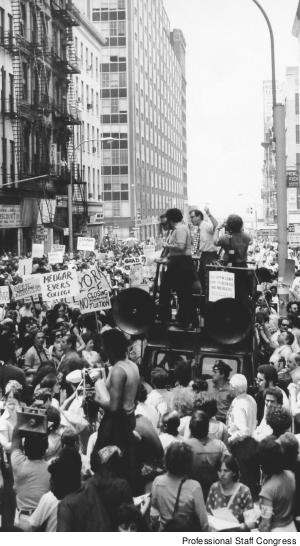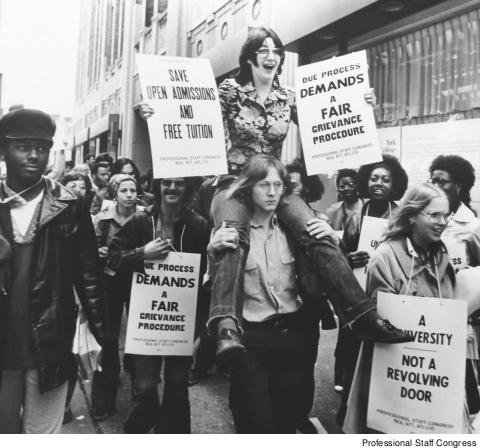50 years of union activism
 |
The PSC Retirees Chapter held a virtual celebration to commemorate the 50th anniversary of the PSC. On April 14, 1972, the Legislative Conference and the United Federation of College Teachers merged to create the Professional Staff Congress. With a half century of labor organizing, coalition activism, political pressure and contract bargaining, members had a lot to reflect on. PSC retirees, many who are longtime union members with some who are 50-year members, spoke about how the union has shaped their lives and shared some of their most memorable union moments.
UNION SOLIDARITY
Several moments stand out in the 50 years that I’ve been a PSC member. In the early days of the PSC, I was present at the meeting where we voted for a strike authorization in response to CUNY administration’s stalling in the first contract negotiations. At that meeting, I felt a sense of union solidarity and the union’s potential power with the willingness to use labor’s strongest tool, withholding our labor and daring to disrupt the “machine.” We didn’t use the tool for a variety of reasons, but the expression of collective resistance was important.
During the 2000s the union began to use labor civil disobedience as a tool of resistance and activism. Many people have been arrested in a series of actions in Albany and in the city, mainly around CUNY issues, but also in solidarity with other workers, including the NYU graduate students’ organizing campaign.
HISTORY MATTERS
Years later, in the 2010s, again in the context of contract negotiations, there was a very active mobilization to prepare for a strike authorization vote, resulting in a 92% “yes” vote. Again, the strike was not used, but the union was stronger for having faced the possibility and having members expressed a willingness to authorize a strike if necessary.
These were times when we weren’t talking about union solidarity and power, but we were exercising it and experiencing it. History shows that unions are effective when they unite and fight together. I’m glad that these struggles for our own interests and the interests of other parts of the working class have been part of the PSC’s history. May these campaigns and coalitions become stronger as we move forward.
John Hyland
Former PSC Treasurer
LaGuardia Community College
 |
WOMEN’S LAWSUIT
The truth is that I didn’t pay much attention to the union nor did I even vote in favor of unionizing. Fortunately, clearer heads prevailed! And I will say I always used the union pocket calendar that was sent to me every fall.
I remember one instance of discrimination that predated the PSC and hopefully would not happen now. I was still working on my PhD, so I was working at City College as a lecturer with the provision that I would be promoted to assistant professor when the degree was completed. When that time came, my department chair said nothing and did nothing. When I approached him, he said something to the effect of, “Why did I care about the promotion and the money because he had heard my husband did well financially?” And he was a very nice man!
Then in the 1970s, there was the lawsuit brought by a group of women from Brooklyn College who realized women were earning considerably less than their male counterparts. I was astonished by that news. I received a settlement in the amount of about $4,000, but the pay disparity was not addressed and continued for my remaining years at City College.
Doris Weisberg
City College of New York
MAKING THINGS POSSIBLE
I don’t know what year I became a dues-paying member, but I began teaching in the City College music department (as it was then called) as a part-time lecturer in 1963, becoming full-time faculty the next year in 1964. Ten years later in 1974 and until 1979, I was an assistant professor. But I was not awarded tenure. This is where the PSC came in. Our union had included in its contract negotiations that if a faculty member had taught as a lecturer, full-time, for seven years, they were granted tenure! It allowed me to continue publishing and teaching at CCNY, becoming an assistant professor with tenure in 1982 and an associate professor in 1986. I retired in January 1998 to conduct a community chorus and complete a book on Estonian music. In 2022, I’m still writing and singing, in part, because the PSC made it possible for me to stay at CCNY for 34 years.
Mimi S. Daitz
City College of New York
FOR A BETTER CUNY
A life-changing day in my 50 years at CUNY was the day I went to testify against the end of open admissions. I met activists from all over CUNY who were passionate about the rights of all CUNY students to have access to a great education. That is the day I first met the beauty of Barbara Bowen and so many other PSC activists. My CUNY life changed, from one of isolation at York College to joining with my colleagues, including Randy Punter and Peter Ranis of York, to fight for a better CUNY and a better world. We became the New Caucus at York. We won our chapter election around the same time Barbara Bowen became PSC president.
So much changed after that. We had pay increases we hadn’t seen before, sabbaticals that more people could afford to take, health care for adjuncts and so much more. Working with the PSC and with fellow union members is among the proudest, most memorable moments of my life, and I am eternally grateful to the union.
Janice Cline
Former PSC York College Chapter Chair
York College
GOING TO COURT
In the 1990s, when Ann Reynolds was CUNY chancellor, the governor and the state legislature were playing their usual budget games. CUNY faced serious cuts, sufficiently so that the dreaded phrase “financial exigency” was loose in the land or at least in the halls of 80th Street, CUNY Central headquarters at the time. Having lived through the 1975 and 1976 slash-and-burn cutbacks, the last thing I wanted to see was more threats to tenure and faculty layoffs. After a few meetings with PSC President Irwin Polishook and PSC Vice President Richard Boris, who were the union leaders at that time, the CUNY University Faculty Senate (UFS) and the PSC went to court. We won on the first round.
COMPACT WITH CUNY
Meanwhile, as I had expected, the budget was revised with increased funding and the exigency averted. CUNY then won the legal case on the appeals level, and rather than appeal further, we worked out a deal. Naturally, the CUNY Board of Trustees has ignored it and subsequent CUNY Central administrations acted as if it was not binding. The deal was a compact that the CUNY Central administration and the chancellor would conduct serious discussions with the PSC and the University Faculty Senate (UFS) if the financial outlook looked threatening. It was honored to a certain degree when Louise Mirrer was CUNY vice chancellor for academic affairs, and it was ignored entirely by Alexandra Logue, author of “Pathways.”
The UFS considered its charge to oversee fair and cooperative governance and academic affairs as a serious role of the senate.
By the way, the chancellor is a member of the University Faculty Senate and until the current occupant of the post, the chancellor always spoke at the monthly UFS meetings or sent a vice chancellor. When I retired, I was honored by the UFS with lifetime membership, with no vote, of course. I attended the UFS meeting when Chancellor Félix Matos Rodríguez had just been named. He came to a September meeting and has not come since.

